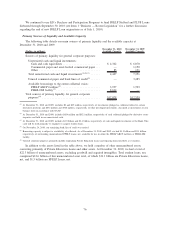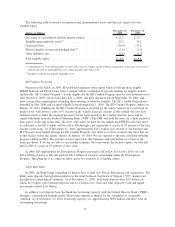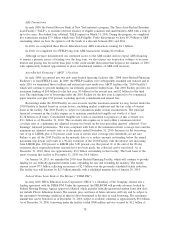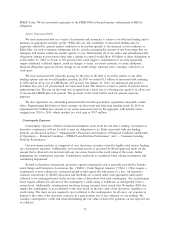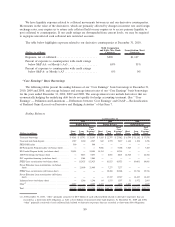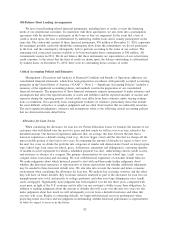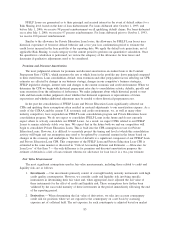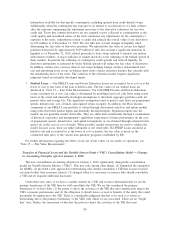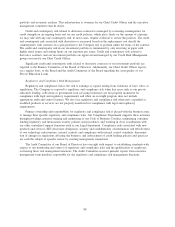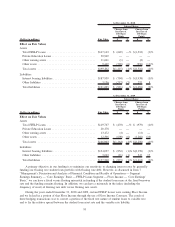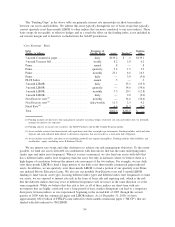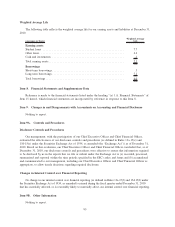Sallie Mae 2010 Annual Report Download - page 86
Download and view the complete annual report
Please find page 86 of the 2010 Sallie Mae annual report below. You can navigate through the pages in the report by either clicking on the pages listed below, or by using the keyword search tool below to find specific information within the annual report.significantly affects the VIE’s economic performance and who has the obligation to absorb losses or receive
benefits of the entity that could potentially be significant to the VIE is very qualitative and judgmental in
nature. However, based on our current relationship with our securitization trusts and other financing vehicles
which are considered VIEs, we believe the assessment is more straightforward. As it relates to our securitized
assets, we are the servicer of those securitized assets (which means we “have the power” to direct the activities
of the trust) and we own the Residual Interest (which means we “have the loss and gain obligation that could
potentially be significant to the VIE”) of the securitization trusts. As a result we are the primary beneficiary of
our securitization trusts and other financing vehicles. See “Note 2 — Significant Accounting Policies” for
further details regarding the adoption of these new rules on January 1, 2010.
Derivative Accounting
The most significant judgments related to derivative accounting are: (1) concluding the derivative is an
effective hedge and qualifies for hedge accounting and (2) determining the fair value of certain derivatives and
hedged items. To qualify for hedge accounting a derivative must be concluded to be a highly effective hedge
upon designation and on an ongoing basis. There are no “bright line” tests on what is considered a highly
effective hedge. We use a historical regression analysis to prove ongoing and prospective hedge effectiveness.
See previous discussion under “Critical Accounting Policies and Estimates — Fair Value Measurement” of
this Item 7 for significant judgments related to the valuation of derivatives. Although some of our valuations
are more judgmental than others, we compare the fair values of our derivatives that we calculate to those
provided by our counterparties on a monthly basis. We view this as a critical control which helps validate
these judgments. Any significant differences with our counterparties are identified and resolved appropriately.
Goodwill and Intangible Assets
In determining annually (or more frequently if required) whether goodwill is impaired, we determine
whether an event has occurred that would indicate to us that there is the potential for the fair value of the
business unit to fall below the book basis of the equity of that business unit. If we determine that this event has
occurred, we perform an analysis to determine the fair value of the business unit. There are significant judgments
involved in determining the fair value of a business unit, including assumptions regarding estimates of future cash
flows from existing and new business activities, customer relationships, the value of existing customer contracts,
the value of other tangible and intangible assets, as well as assumptions regarding what we believe a third party
willing to pay for all of the assets and liabilities of the business unit. This calculation requires us to estimate the
appropriate discount and growth rates to apply to those projected cash flows and the appropriate control premium
to apply to arrive at the final fair value. The business units for which we must estimate the fair value are not
publically traded and often there is not comparable market data available for that individual business to aid in its
valuation. We use a third party appraisal firm to provide an opinion on the fair values we conclude upon.
Risk Management Processes
Our Approach
The monitoring, assessment and oversight of risk are shared responsibilities throughout the Company.
Each business division is primarily responsible and accountable for managing risks specific to its area. Our
executive management team and centralized support functions, including compliance, credit risk, human
resources, legal, information technology, finance and accounting, are responsible for providing our business
divisions with the training, systems and specialized expertise necessary to properly perform their risk
management duties. Executive management, individually and through participation in various committees, are
ultimately responsible for the management of risk across our businesses. Our Risk Assessment Department
regularly monitors and reports to the Audit Committee of our Board of Director on the effectiveness of various
aspects of our risk management activities.
Our Code of Business Conduct and the on-going training our employees receive in many compliance
areas provide a framework for our employees to conduct themselves with the highest integrity. We instill a
risk-conscious culture through communications, training, policies and procedures. We have strengthened the
85



